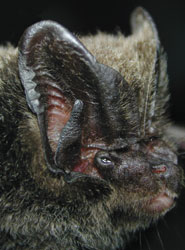It all started in 2001 when I was awarded a grant from the Royal Society, matched with funding from the Chinese Academy of Sciences. Back then, my collaborator in the Institute of Zoology at the Chinese Academy of Sciences in Beijing, Professor Zhang Shuyi, was working in a small office with basic equipment. Today when I visit him at the East China Normal University in Shanghai, Professor Zhang runs a research group of 25 people using state-of-the-art technology, and the Institute of Zoology in Beijing has relocated to a modern building overlooking the Beijing Olympic Stadium – nicknamed the Bird’s Nest due to its remarkable architecture – where another ten research students are based.
Professor Zhang’s group has published 24 papers in the past year, many in quality journals. The laboratories are equipped with top-quality equipment and there are few bureaucratic obstacles that stand in the way of research. Professor Zhang has recently accepted a further position at a university for national minorities in Beijing. His latest lab is fitted with rows of PCR (polymerase chain reaction) machines which amplify tiny amounts of DNA, and a gene sequencer – all funded by the Government. Can you imagine that happening in Britain? I don’t think so. My last trip to Shanghai was one of the most stimulating scientific visits I have ever experienced.
We have discovered a new species of bat that is similar to the rare barbastelle bat of Europe
My Chinese colleagues and I have worked in the field in many areas of China, and with funding from the Darwin Initiative – a programme that aims to promote biodiversity conservation and sustainable use of resources around the world – we have built a research centre (The Darwin Initiative Centre for Bat Research) near Beijing and are developing an education centre. The research centre has a display area, dormitories, a kitchen and dining room, experimental rooms, bat-housing facilities and a large flight area containing a colony of fishing bats. The entrance hall contains a small museum with a large window at the end. It’s amazing to sit at the window around dusk and watch the bats fly down to a pond to catch fish with their large feet. They will feature in a forthcoming BBC series entitled Wild China.
So what have we learnt in the seven years that I have worked in China? We have already published 12 papers on a wide range of topics that include studies describing the echolocation and foraging behaviour of a bat species found only in China. It is based at a roost in a Buddhist temple – one of the oldest wooden buildings in the world. We have also studied the behaviour of bats that live in the stems of bamboos and have begun to resolve complicated taxonomic issues surrounding the 100 or so Chinese bat species, by comparing gene sequences among species. As a consequence of this work, we have discovered a new species of bat that is similar in appearance to the rare barbastelle bat of Europe, but is genetically very different. We are about to lobby for the protection of roosting sites used by this bat, which is currently only known from around Beijing. The co-evolution between bats and the SARS-like coronoviruses they host has also proved a fruitful area of research. My favourite work, however, involved a study of molecular evolution – evolution at the scale of DNA, RNA and proteins – and I have been privileged to work with some very gifted Chinese students who have grasped complex genetic techniques and methods for evolutionary analyses very competently, largely by reading material, in English, on the internet.
Take the FOXP2 gene, for example – often simplistically dubbed the ‘speech and language gene’. It has been implicated in the evolution of human language, first because mutations in the gene have been shown to cause speech defects, and second because we know the gene underwent changes around the time that language developed. More recently, however, patterns of gene expression in birds, humans and rodents have suggested a wider role for the FOXP2 gene in producing the sounds animals make. Numerous reports have established that FOXP2 shows very little genetic variation across even distantly related vertebrates – from reptiles to mammals – suggesting that the gene is strongly conserved and hence mutations that may affect its standard function are not selected.
When we show small bats to children, they say 'Yes, we have eaten those'
In echolocating bats, on the other hand, our work has found that this gene shows unparalleled variation and that FOXP2 mutations among bat lineages correspond well to contrasting forms of echolocation. Like speech in humans, bat echolocation involves producing complex vocal signals via sophisticated coordination of the mouth and face. The involvement of FOXP2 in the evolution of echolocation adds weighty support to the theory that FOXP2 functions in coordinating sound production and associated patterns of movements, not only in bats but also in humans and other vertebrates.
Visiting China has been a fantastic experience. In collaboration with my Chinese partners, I can get research done quickly and in return I provide ideas and contribute to the writing of papers, so both sides benefit. But my last visit a few months ago highlighted some of China’s paradoxes – it’s a country where state control mixes with rampant free enterprise, and where huge investment in science sits alongside some of the world’s most pressing issues regarding pollution and wildlife conservation.
Although I can visit labs that are among the best-equipped in the world, I have never seen the sun in Beijing because of the thick smog. We can drive for days at a time and see hardly any birds, and when we show small bats to children, asking if they know what they are, they answer ‘Yes, we have eaten those’. Nevertheless, for me it has been a great privilege contributing to capacity-building for research in China. I am eager to write the next grant proposal so that more Chinese students can visit my lab in Bristol, and my work in China can continue.
Professor Gareth Jones / Biological Sciences

